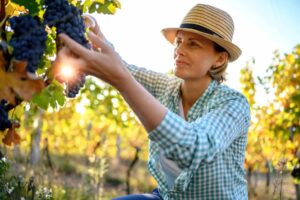Risotto al Sagrantino di Montefalco
R i s o t t o a l S a g r a n t i n o d i M o n t e f a l c o
Ah risotto, one of the best known dishes of Italian cuisine! There are many secrets behind the success of an excellent risotto, and everyone has their own technique.
Precisely for this reason, many foreign tourists want to get to know and learn the techniques of Italian cuisine, famous all over the world (and who can blame them?!)
To make our beloved Italian and regional cuisine known here in Italy, the cooking school Mama Isa’s Cooking School!
The Mama Isa’s Cooking School in Veneto holds cooking courses entirely in English open to everyone, but above all to tourists and foreign visitors who want to get to know typical Italian cuisine in depth.
And what better recipe to prepare than risotto with Sagrantino di Montefalco? In fact, this dish combines the tradition of good Italian rice with one of the native wines of Umbria. Enclosing two excellences of Italian cuisine in a single dish is truly something magical in the kitchen!
So here’s the Montefalco Sagrantino rice recipe made by the friends of Mama Isa’s Cooking School!
The recipe for risotto with Sagrantino di Montefalco
Ingredients for 4 people:
- 320 g of Carnaroli rice
- 60 g of Parmigiano Reggiano aged 36 months (finely grated)
- 60 g finely chopped shallots
- 40 g of butter
- 50 g of Montioni Extra Virgin Olive Oil
- 1 liter of meat broth
- salt
- 250 ml of Montefalco Sagrantino Montioni

Procedure for risotto with Sagrantino
1) Brown the shallot in a saucepan with half the butter and the oil.
2) When it has taken on a nice golden colour, add the rice and toast it over medium heat for a few minutes, continuing to stir vigorously. Salt lightly. Slowly add the wine.
3) Finish cooking over medium heat, adding the hot broth a little at a time as it is consumed and continue stirring with a wooden risotto spoon. Season with salt.
4) Cooking depends on taste, but the grain should maintain a certain consistency. Turn off the heat and mix vigorously and add the remaining butter and grated Parmesan.

The wisdom of Mama Isa’s cooking school
Many could cry their hearts in using the precious Montefalco Sagrantino as a wine for risotto, but at the first taste, however, you will understand that it was worth it!
Thanks to Mama Isa’s Cooking School for using Montioni products for her precious recipe and for making Italian food excellence known all over the world through its cooking classes!
Are you passionate about cooking and would you like to take part in a Mama Isa’s Cooking School course to perfect your technique or to learn how to make some new dishes?
Visit their website: https://isacookinpadua.altervista.org/
See you next recipe!
On occasion, the winemaker may decide to leave them in if the grapes themselves contain less tannin than desired. This is more acceptable if the stems have ‘ripened’ and started to turn brown. If increased skin extraction is desired, a winemaker might choose to crush the grapes after destemming.
Wine is one of the most civilized things in the world and one of the most natural things of the world that has been brought to the greatest perfection, and it offers a greater range for enjoyment and appreciation than, possibly, any other purely sensory thing.
Ernest Hemingway Tweet
Removal of stems first means no stem tannin can be extracted. In these cases the grapes pass between two rollers which squeeze the grapes enough to separate the skin and pulp, but not so much as to cause excessive shearing or tearing of the skin tissues. In some cases, notably with “delicate” red varietals such as Pinot noir or Syrah, all or part of the grapes might be left uncrushed (called “whole berry”) to encourage the retention of fruity aromas through partial carbonic maceration.
The Grapes
The quality of the grapes determines the quality of the wine more than any other factor. Grape quality is affected by variety as well as weather during the growing season, soil minerals and acidity, time of harvest, and pruning method. The combination of these effects is often referred to as the grape’s terroir.
Grapes are usually harvested from the vineyard from early September until early November in the northern hemisphere, and mid February until early March in the southern hemisphere.
In some cool areas in the southern hemisphere, for example Tasmania, harvesting extends into May. The most common species of wine grape is Vitis Vinifera, which includes nearly all varieties of European origin. The most common species of wine grape is Vitis Vinifera, which includes nearly all varieties of European origin.

Manual harvesting is the hand-picking of grape clusters from the grapevines. In the United States, some grapes are picked into one- or two-ton bins for transport back to the winery. Manual harvesting has the advantage of using knowledgeable labor to not only pick the ripe clusters but also to leave behind the clusters that are not ripe or contain bunch rot or other defects. This can be an effective first line of defense to prevent inferior quality fruit from contaminating a lot or tank of wine.
Destemming is the process of separating stems from the grapes. Depending on the winemaking procedure, this process may be undertaken before crushing with the purpose of lowering the development of tannins and vegetal flavors in the resulting wine. Single berry harvesting, as is done with some German Trockenbeerenauslese, avoids this step altogether with the grapes being individually selected.
Crushing is the process when gently squeezing the berries and breaking the skins to start to liberate the contents of the berries. Destemming is the process of removing the grapes from the rachis (the stem which holds the grapes).
In traditional and smaller-scale wine making, the harvested grapes are sometimes crushed by trampling them barefoot or by the use of inexpensive small scale crushers. These can also destem at the same time. However, in larger wineries, a mechanical crusher/destemmer is used. The decision about destemming is different for red and white wine making. Generally when making white wine the fruit is only crushed, the stems are then placed in the press with the berries. The presence of stems in the mix facilitates pressing by allowing juice to flow past flattened skins.

Katerina Monroe
@katerinam • More Posts by Katerina
Congratulations on the award, it's well deserved! You guys definitely know what you're doing. Looking forward to my next visit to the winery!
